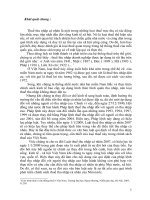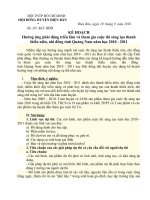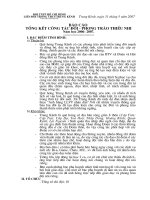TTN - DV2 (04-03-2014)
Bạn đang xem bản rút gọn của tài liệu. Xem và tải ngay bản đầy đủ của tài liệu tại đây (56.17 KB, 9 trang )
EXERCISE-INCLUDE BRONCHOCONSTRICTION IN SCHOOLAGED CHILDREN WHO HAD CHRONIC LUNG DISEASE IN
FANCY
By: bs TRẦN THỊ THU HÀ (KHOA Dv2)
OBJECTIVES
•
To assess for exersice-induced bronchoconstriction in 8- to 12-year-old
children who had chronic lung disease (CLD) infancy, and to evaluate
the response of bronchoconstriction to bronchodilation with albuterol
in comparison with preterm and term controls.
STUDY DESIGN
•
Ninety-two children, including 29 with CLD, 33 born preterm at <32
weeks’ gestation, and 30 born at term, underwent lung spirometry
before and after cycle ergometry testing and after postexercise
bronchocondilation with albuterol.
RESULT
•
Doctor-diagnosed asthama and exercise-induced wheeze were
reported more frequently in the CLD group than in the preterm
and term groups, but only 10% were receiving a bronchodilator.
They were do differnces among the groups in peak minute
ventilation, oxygen uptake, or carbon dioxide output at maximum
exercise.
CONTINUOUS
•
After maximal exercise, predicted forced expiratory volume in 1 second (FEV1)
decreased from a mean baseline value of 81.9% (95% CI, 76.6-87.0%) to 70.8%
(95% CI, 65.5-76.1%0 after exercise in the CLD group, from 92.0% (95% CI, 87.296.8%) to 84.3% (95% CI 79.1-89.4%) in the preterm group, and from 97.5%
(95% CI, 92.5-102.6%0) to 90.3% (95% CI 85.1-95.5%) in the term group.
CONTINUOUS
After albuterol administration, FEV1
increased to
86.8% (95% CI, 81.7-92.0%0 in the CLD group, 92.1%
(95% CI, 87.3-96.9%) in the preterm group, and 97.1%
(95% CI, 92.0-102.3%) in the term group.
CONTINUOUS
•
The descrease in predicted FEV1 after exercise and increase in
predicted FEV1, after bronchodilator use were greatest in the CLD
group (-11.0% [95% CI, -18.4 to 3.6%] and 16.0% [95% CI, 8.6-23.4%],
respectively; P< .005 for both), with differences of <8% in the 2 control
groups.
CONCLUSION
•
School-age children who had CLD infancy had significant exerciseinduced bronchoconstriction that responded significantly to
bronchodilation. Reversible exercise-induced bronchoconstriction in
common in children who experienced CLD in infancy and should be
actively assessed for and treat.
(J Pediatr 2013; 162:813-8).
•
THE END









